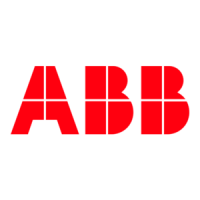ETL600 1KHW001489-EN ABB Switzerland Ltd
• Parity: None, Odd, Even
• Protocol:
•
Character based protocol: this is the configuration for general
asynchronous data communication based on individual
character transmission. This selection allows unrestricted
parameter configuration for the number of data bits, stop bits
and parity mode;
•
RP570/RP571 / FT1.2: this is the configuration for SCADA
applications using the ABB proprietary protocol RP570/RP571
based on IEC60870-1-5 FT1.2 with 8 data bits, 1 stop bit and
even parity;
•
Asynchronous DNP 3.0: this is the configuration for SCADA
applications using the proprietary implementation of
asynchronous DNP3.0 based on IEC60870-1-5 FT3 with 8 data
bits, 1 stop bit and no parity.
• Three different flow control modes are available:
•
RTS / CTC & DCD:
An RTS request from DTE (e.g. RTU) to the V.24 port is
granted CTS when the corresponding transmission channel is
available in transmit direction (multiplexer frame is
synchronized for MOD600 or data carrier is operational for
NSK600). As soon as CTS is granted, dataflow is permitted
through the corresponding channel in transmit direction. In
case of port sharing operation, no collision detection with other
V.24 ports transmitting on the same channel is implemented.
When the DTE clears RTS to the V.24 port, CTS is cleared
accordingly.
If the corresponding V.24 port is transmitted on an NSK600
modem, the RTS request enables the data carrier on the AF
signal and CTS is granted as soon as the carrier is available.
Towards the DTE, DCD is signaled whenever the transmission
channel is available in receive direction (received multiplexer
frame is synchronized for MOD600 or receive carrier is
operational for NSK600).
•
None:
Independently from any RTS request by the DTE, CTS is
always granted.
Dataflow is always permitted through the corresponding
channel in transmit direction. In case of port sharing operation,
no collision detection with other V.24 ports transmitting on the
same channel is implemented.
For NSK600 modem, this flow control mode, permanently
enables the carrier on the AF signal in transmit direction.
Towards the DTE, DCD is signaled whenever the transmission
channel is available in receive direction (received multiplexer
frame is synchronized for MOD600 or receive carrier is
operational for NSK600)
Configuration and Set-up November 2005 5-27

